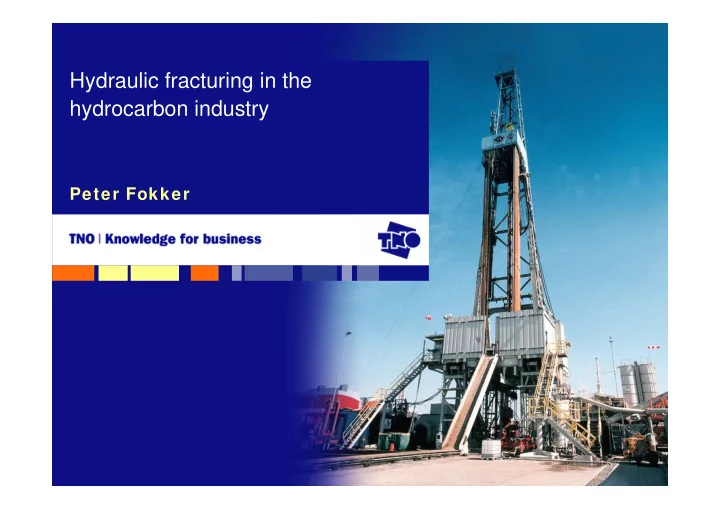

Hydraulic fracturing in the hydrocarbon industry Peter Fokker
Outline • Introduction • Hydraulic fracturing – basics • Types of applications • Considerations of design • Monitoring • Concluding remarks
Introduction Stimulation of under-performing wells • Matrix acidizing • Dissolve “skin” with acid (HCl, HF) • Not working with all kinds of damage • Concern of tubing corrosion • Hydraulic fracturing • Increase inflow area • Pump fluid with high pressure – break the formation • Pump “proppant” in open fracture • Keep frac open after shutin • High-permeability path from reservoir to well
σ 1 Hydraulic fracturing – Basic concepts • Stress: maximum stress vertical; minimum and medium stresses σ 3 horizontal σ 2 • Modes of fracturing Mode I: Opening Mode II: Sliding Mode III: Tearing • Hydraulic fracturing: Tensile (mode I) – Vertical fracture has least resistance
Hydraulic fracturing – Visualization of the process • Processes in hydraulic fracturing Wellbore Leakoff Injection Friction Fracture Propagation Rock Strength Elastic opening Stress Intensity Pressure support Factor of fracture walls
Hydraulic fracturing – Concept ( ) = K f w , A • K I : Stress intensity – measure I ( ) = − σ w ( y , z ) f p ( y , z ) of singular stress behaviour 3 V beyond the tip = fracture w A fracture • Length increases when K I > K Ic dV = − Q Q inj leakoff dt ∫ • Volume balance = Q v dA leakoff leakoff fracture ( ) = − ⋅ • Leakoff correlation v p p d leakoff frac res penetrated t ∫ = d v dt ' penetrated leakoff 0
Hydraulic fracturing – Complicating issues • Profile of the minimum in-situ stress • Elasticity profile • Influence of pore pressure increase and temperature decrease on stress (poro-elasticity and thermo-elasticity) • 3D pore pressure field complicates leakoff correlation • Plugging of the fracture interior
Layered Reservoir • Stress Profile σ 3 log k • Elasticity Profile • Permeability Profile • Porosity Profile depth injection
σ 3 log k Fracture vs time depth injection
Example: Influence of a stress barrier 900 400 950 350 Increased stress in 1000 300 Fracture length (m) Shale layer shale layer 1050 250 Depth (m) ∆σ = 0 MPa Fracture 1100 Fracture length 200 ∆σ = 1 MPa height 1150 150 ∆σ = 2 MPa ∆σ = 3 MPa 1200 100 1250 50 1300 0 0 2000 4000 6000 8000 Time (days)
Width and length contours ( ∆σ = 2 MPa)
Hydraulic fracturing – Types of applications Massive hydraulic fracturing • Large treatments • Low-permeability reservoir • Create additional contact area • Multiple fractures in a horizontal well
Hydraulic fracturing – Types of applications Tip-Screen-Out fracturing / Frac & Pack • Goal: Bypass damage • Typically in higher-permeability reservoir • Short fracture • Tip-Screen-Out to increase fracture width
Hydraulic fracturing – Types of applications Water Injection under Fracturing Conditions Plugging and Channelling in Fluid flow in Reservoir Fracture Fracture Cracking Fluid flow in Fracture Reduced Permeability
Hydraulic fracturing – Types of applications Barnett shale • Very low permeability • Naturally fractured • Goal: interconnected fracture network • Waterfracturing • Monitoring
Design considerations • The goal of hydraulic fracturing is • Dimensionless fracture economic conductivity ⋅ k w = f • Expected production C ⋅ fD k L • Analytic expressions (Prats) • Semi-analytic calculations Optimum value: • Reservoir simulation • High k: maximize width and • Connection with Geology proppant permeability • Flow barriers • Low k: maximize length • Permeability • Proppant placement • Heterogeneity • Natural fractures
Design considerations More input for design: • In-situ stresses } • Fracturing pressures Minifrac test • Leakoff behaviour • Effects of layering: • Containing capacity • Connection • Natural fractures • Poro-elasticity • Thermo-elasticity
Monitoring Build up a knowledge base: • Treatment performance • Productivity monitoring Treatment performance monitoring • Rates & Pressure traces (e.g. Tip-Screen-Out) • Use fracture simulator • Tiltmeters • Surface • Offset well • Microseismic mapping two downhole receivers
Monitoring Build up a knowledge base: • Treatment performance • Productivity monitoring Productivity monitoring • Well testing: Effective fracture size • Productivity evaluation e.g. Stimulated Volume Analysis
Concluding remarks • What is the goal? • Monitoring • Contact area Build up a knowledge base • Bypass damage • Rates • Connect to natural fractures • Pressures • Temperatures • Design • Tiltmeter mapping • Reservoir permeability • Microseismics • Fracture conductivity • Productivity • Geology • Rock mechanics • Minifrac tests • Design software • Fluid selection • Proppant selection
Recommend
More recommend